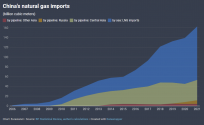You are using an out of date browser. It may not display this or other websites correctly.
You should upgrade or use an alternative browser.
You should upgrade or use an alternative browser.
Climate Change and Renewable Energy News and Discussion
- Thread starter FairAndUnbiased
- Start date
We don't know, it might honestly not need it, or they may decide to go with it anyways.Does china need power of Siberia 2 in light of the renewal energy push?
not at the current rate of solar expansion. That's probably why they haven't signed anything.Does china need power of Siberia 2 in light of the renewal energy push?
One thing is for sure as I said, coal usage will drop significantly over the next 10 years (even in my model assuming 5% increase in electricity generation/year). NG can replace coal in a lot of the refining & industrial type of usage. NG is also needed for heating, so I don't think their NG usage will drop. It may just stop increasing the way people have been expecting.
The drop in coal usage is why regions like Shanxi and Inner Mongolia really have to step up their investment and attraction of renewable energy. At present, they still have cheap electricity to offer. They may not have that in 10 years
Are oil and gas exporting countries doomed without major push to new industries?not at the current rate of solar expansion. That's probably why they haven't signed anything.
One thing is for sure as I said, coal usage will drop significantly over the next 10 years (even in my model assuming 5% increase in electricity generation/year). NG can replace coal in a lot of the refining & industrial type of usage. NG is also needed for heating, so I don't think their NG usage will drop. It may just stop increasing the way people have been expecting.
The drop in coal usage is why regions like Shanxi and Inner Mongolia really have to step up their investment and attraction of renewable energy. At present, they still have cheap electricity to offer. They may not have that in 10 years
Not just countries, but also fossil fuel provinces in china. That's why you see shanxi, inner Mongolia, heilongjiang and Jilin all pushing hard for renewables energy farms and local production.Are oil and gas exporting countries doomed without major push to new industries.
Also why Saudi Arabia is partnering up with china
Perhaps time to develop crops that can grow in high-altitude, low-temperature & low-oxygen environment (Tibetan Plateau) and/or extreme temperature-contrasting, low-water availability and low-nutrient soil environment (Gobi and Taklamakan Deserts).View attachment 113286
The map at the top, courtesy , shows Asia after all ice melts.
View attachment 113287
The green breadbasket of China is up to 150 m, so perhaps most of safely above 60 m. A bigger issue is the precipitation pattern that would ensue, plus bread baskets in the lowlands of Bengal, Myammar, Thailand, Vietnam etc.
Regardless of "food safety", all scenarios require significant adaptation from humans.
Otherwise, digging tunnels underneath the Tibetan Plateau and setting up farming inside those climate-controlled man-made caverns, and/or desert reclamation across the Gobi and Taklamakan for farming will have to do.
Last edited:
Rain patterns will change so Gobi desert might become a grassland and Yellow River Valley could become a forest again.Perhaps time to develop crops that can grow in high-altitude, low-temperature & low-oxygen environment (Tibetan Plateau) and/or extreme temperature-contrasting, low-water availability and low-nutrient soil environment (Gobi and Taklamakan Deserts).
Otherwise, digging tunnels underneath the Tibetan Plateau and setting up farming inside those climate-controlled man-made caverns, and/or desert reclamation across the Gobi and Taklamakan for farming will have to do.
It will happen. China's energy requirements are huge, and there is a government push to reduce coal pollution.Does china need power of Siberia 2 in light of the renewal energy push?
One good example of this is recently signed deal with Turkmenistan for natural gas.

Power of Siberia and the new Line D pipeline from Turkmenistan won't be quite enough to replace current LNG imports let alone surging demand for natural gas in China.
Last edited:
a few big news for Mingyang
MingYang is really getting into PV business with its 600W+ modules. It's cooperating with German company TUV on various PV initiatives.
MY , Guangdong Zhongshan govt and NEA group from Germany have signed agreement on major hydrogen project.
World's largest onshore wind turbine rolled off MY's production line in Daqing. Interesting how Heilongjiang is transitioning off oil with wind farms and now wind plant. Another case of fossil fuel part of China moving to renewables.
MY win bind for 465 MW of offshore wind power off Guangxi. Major bid for offshore. Guangxi is planning for GW offshore wind projects, so there are plenty of opportunities for MY to win more bids here. It has won 26.5% of all bids in Guangxi
MingYang is really getting into PV business with its 600W+ modules. It's cooperating with German company TUV on various PV initiatives.
MY , Guangdong Zhongshan govt and NEA group from Germany have signed agreement on major hydrogen project.
World's largest onshore wind turbine rolled off MY's production line in Daqing. Interesting how Heilongjiang is transitioning off oil with wind farms and now wind plant. Another case of fossil fuel part of China moving to renewables.
MY win bind for 465 MW of offshore wind power off Guangxi. Major bid for offshore. Guangxi is planning for GW offshore wind projects, so there are plenty of opportunities for MY to win more bids here. It has won 26.5% of all bids in Guangxi
Last edited:
